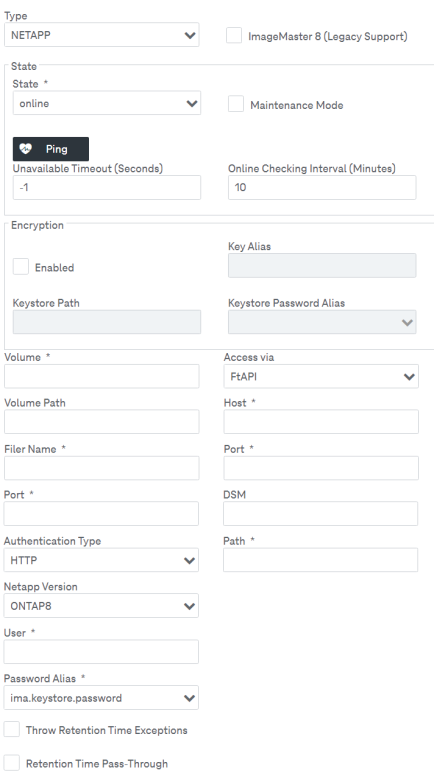NetApp
ImageMaster supports NetApp storage, which requires a configuration via a dialog as shown further below.
ImageMaster requires an activated ONTAPI (ZAPI) service within the NetApp ONTAP software. The storage administrator must verify that ONTAPI is enabled. For details see chapter NetApp requirements – ONTAPI (ZAPI) in the installation manual [IM ImageMaster].
First, select a connection type in the Access via drop-down. Further configuration parameters depend on the selection:
The table in the bottom describes the other NetApp-specific parameters.

Figure 80: Archives – NetApp archive properties
|
Parameter |
Mandatory |
Description |
|---|---|---|
|
Volume |
Yes |
The name of the volume where the archive is located |
|
Volume Path |
No |
The volume path of the archive This is the additional relative path of the archive inside the volume, for example: If the volume is “VOL1” and the archive is placed in the directory “employees/archive” under “VOL1”, the Volume Path will be “employees/archive”. If “/data/vol1” is the mount point of the volume “VOL1”, in contrast to the volume path, the absolute path in the archive (ftp or sftp) is “/data/vol1/employees/archive”. If the configuration entries for “Path” and “Volume Path” are inconsistent, the archive will be corrupted! |
|
Filer Name |
Yes |
The name of the NetApp Filer |
|
Port |
Yes |
Port of the server |
|
Authentication Type |
Yes |
Transport type (HTTP / HTTPS) |
|
Netapp Version |
Yes |
Supported versions of NetApp |
|
User |
Yes |
The username |
|
Password Alias |
Yes |
The password alias for accessing the NetApp |
|
Throw Retention Time Exception |
N/A |
|
|
Retention Time Pass-Through |
N/A |
|
|
Access via |
Yes |
Defines the actual archive type to be used in the NetApp configuration For properties of this archive refer to the respective archive types. NOTE: If you select access via FTP or SFTP, do not activate the option “Mark Files Read Only”! |
|
Table 25: Archives – NetApp |
||